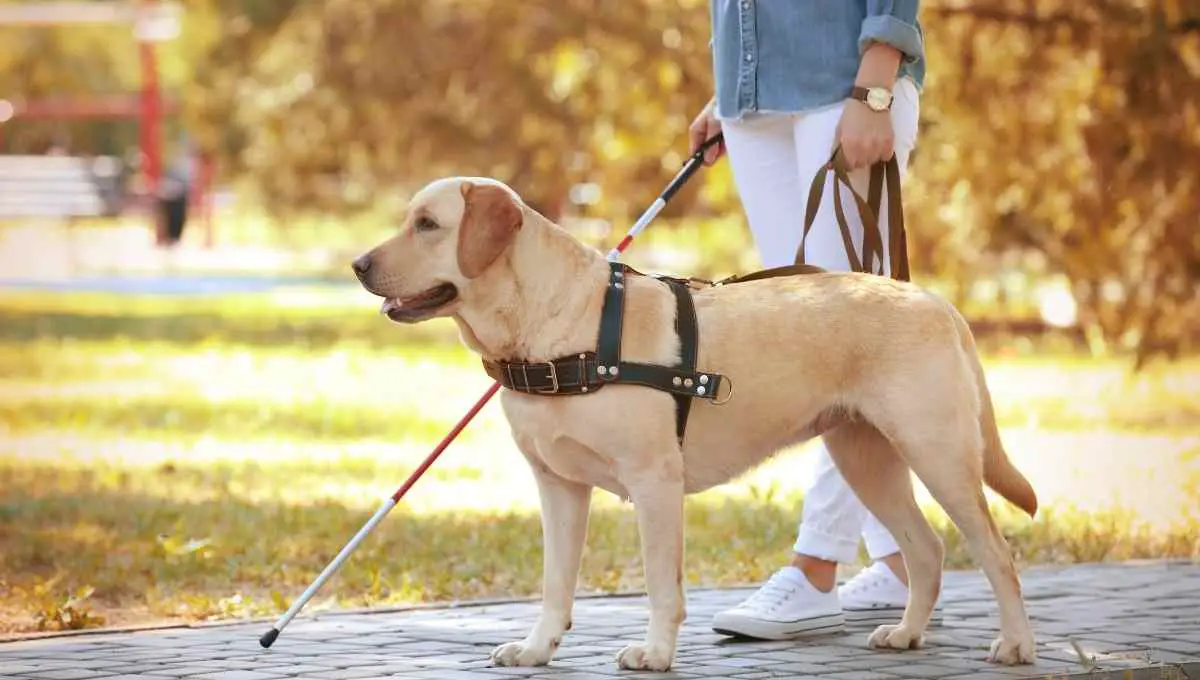How Do Guide Dogs Know Where to Go? (Doing This Works)

For a small percentage of the blind or visually impaired population, guide dogs are the only thing that helps them lead a somewhat normal life and perform everyday tasks. How do guide dogs know where to go, though?
Guide dogs know where to go by practicing and memorizing the routes of common places their owners often visit. Guide dogs are taught this during their initial training. This is accomplished through a series of verbal commands and hand signals by the owner.
While it’s one thing for a guide dog to memorize a route, safely leading its owner to the destination is another story. In this blog post, we’ll dive deeply into some other important things you should know and common questions that people have about guide dogs.
This post contains affiliate links from Amazon and other stores. This means Yard Blogger may earn a commission if you make a purchase using any of our links. Please refer to our full affiliate disclosure policy for full details.
Here’s a Quick Pro Tip!
One of the best and most popular harnesses for guide dogs is the Light Nickel Hardware Nylon Dog Harness from Dean & Tyler
This lightweight dog harness is extremely well made and very comfortable for your dog. Many owners with mobility issues have praised the harness for helping with their balance, allowing them to get around much easier.
- How Does a Guide Dog Know Where to Take Its Owner?
- How Do You Tell a Guide Dog Where to Go?
- How Do Guide Dogs Know When to Cross a Road or Street?
- How Do Guide Dogs Know When to Get Off the Bus?
- How are Guide Dogs Trained?
- What Types of Dogs Can Be Used as Guide Dogs?
- Do Guide Dogs Know Their Owners are Blind?
- How Do I Get a Guide Dog?
- Final Thoughts
How Does a Guide Dog Know Where to Take Its Owner?
A guide dog’s training includes going to and from common destinations that their owner needs to get to. This is something that the guide dog memorizes and dedicates to memory.
If the owner needs to get to a new place unknown to either them or the dog, they must ask for directions from a stranger and then direct the guide dog using voice commands or hand signals.
As previously mentioned, guide dogs practice getting to and from common destinations while still training. Apart from this, they only know where to go based on information they receive through voice commands and hand signals from their owner.
An important thing to remember is that the guide dog can’t read the owner’s mind, and it will not know where to go without being told by the owner. Guide dogs are extremely smart, but they aren’t mind readers.
How Do You Tell a Guide Dog Where to Go?
It is the responsibility of the guide dog owner to learn the voice commands and hand signals that are involved with telling the dog where to go and what to do. Hand signals include but are not limited to forward, left, and right.
Voice commands are more commonly used, as the owner’s hands will not always be free to gesture and motion. They may not be able to tell their dog to “take me to the grocery store,” but through step by step direction, the guide dog will always get their owner to the proper destination.
You might also enjoy our post on Who Picks up a Guide Dog’s Poop?
How Do Guide Dogs Know When to Cross a Road or Street?
The short answer is that guide dogs, on their own, do not know when it is safe to cross a road or street.
It’s up to the owner to decipher when it is safe enough to do so and then command the dog to lead them safely through an intersection.
Most intersections are equipped with Accessible Pedestrian Signals that emit noise indicating when it is safe to cross the street. Apart from these devices, blind individuals must learn to listen to traffic sounds to know when the best and safest time is to cross a street.
This skill may take time to master, but it is essential to learn to live life as a blind or visually impaired person.
How Do Guide Dogs Know When to Get Off the Bus?
Although guide dogs can lead their owner to a bus stop, they cannot read numbers and will not be able to choose the correct bus for their owner.
It’s up to the owners themselves to select the right bus. This is typically done through communication with pedestrians or the bus driver.
Once getting onto the bus, the guide dog can lead the owner to an empty seat. Using proper etiquette received in their training, the guide dog will politely sit and wait for their owner to pay the bus driver and exit the vehicle.
How are Guide Dogs Trained?
There are a few different options for guide dog training. Still, it is typically done by either the owner or at non-profit schools that specialize in training dogs for special services.
This process usually begins as soon as the puppy can be safely taken away from its mother and placed into the care of the training school.
The puppy is socialized and taught basic obedience skills by a group of volunteers who come to the facility for the sole purpose of spending time with the puppies.
Once the puppy is properly socialized and understands basic commands, it is taken to a professional dog trainer, who then proceeds to teach it more complex skills, including:
- Walking in a straight line
- Stopping at curbs
- Dealing with large crowds
- Ignoring outside distractions
- Proper behavior and etiquette in public spaces
The dog also learns more complicated skills, such as leading its owner around obstacles like fallen branches or low-hanging limbs. Overall, the entire training process from start to finish lasts around 12 to 18 months.
You might also enjoy our post on How to Clean Dog Paws After a Walk
What Types of Dogs Can Be Used as Guide Dogs?
Many different dog breeds can be used as guide dogs, but the most common are:
- German shepherds
- Golden retrievers
- Labrador retrievers
- Poodles or Goldendoodles (hypoallergenic options for those who are allergic to dogs)
Other breeds of dogs are also eligible to be used as guide dogs, but these are the most commonly used ones.
These dogs are then donated to non-profit schools by someone who breeds and raises dogs and then given freely to someone who needs a guide dog.
Do Guide Dogs Know Their Owners are Blind?
It is a point of contest whether dogs know that their owners are blind or not, but the general consensus is that they do not.
According to a 2008 study published in Animal Cognition, which looked at how dogs ask their owners for food, guide dogs use the same methods as everyday pet dogs.
Dogs will typically look at their empty food bowl and then back at their owner when they are hungry and waiting for food. According to the study mentioned above, guide dogs did the same thing.
Eventually, they would add licking or whining noises or even throw in an occasional bark to get the owner’s attention.
Although they may not understand that their owner cannot see, guide dogs learn to adapt to their surroundings and pick up on the fact that their owner responds better to auditory cues than visual ones.
So while a guide dog probably doesn’t know that their owner is blind, they learn to interact with them in a way that doesn’t require the owner to see what the dog is doing.
How Do I Get a Guide Dog?
According to the Guide Dog Foundation, to apply for a guide dog, applicants must be legally blind. They must demonstrate the need for a guide dog to help them remain safe and effective in their everyday travel.
Once you can show that you meet these requirements, the foundation will begin matching you with the appropriate guide dog. This can sometimes be a meticulous process as it takes time to match the owner to a dog with the proper temperament to fulfill the needs required.
Guide dogs are not one size fits all. A person’s mobility, lifestyle, personality, and physical needs must be considered during the matching process.
If the wrong owner is paired with the wrong dog, the two will not match, and all of the dog’s training will be wasted as it could prove challenging to pair a dog with a new owner.
It could also prove hazardous to the blind owner of the dog. They may not comprehend when a dog is attempting to warn them of impending danger, such as an obstacle in their path or dangers in the surrounding area.
Because of this, future guide dog owners are typically invited to spend up to two weeks at a training facility with the dog they are paired with within a structured, monitored environment. There are no cut corners when it comes to bonding a guide dog and its owner.
It is important to remember that these dogs (sometimes valued at thousands of dollars) have been donated at the expense of dog breeders for the sole purpose of helping a person in need.
You might also enjoy our post on How To Train Your Dog to Sleep Outside
Final Thoughts
Hopefully, this article helped answer a few questions that you had regarding guide dogs and their capabilities and the training process they go through.
These remarkable animals can sometimes be the only thing standing between a person leading a somewhat normal life or never being able to leave the house alone.
Guide dogs are cared for and treated with the utmost care and respect by their owners and trainers and live happy, fulfilled lives doing what they love and are trained to do.
For more information about guide dogs and the process they go through, visit the Guide Dog Foundation to learn more and to see if you qualify for a guide dog.






